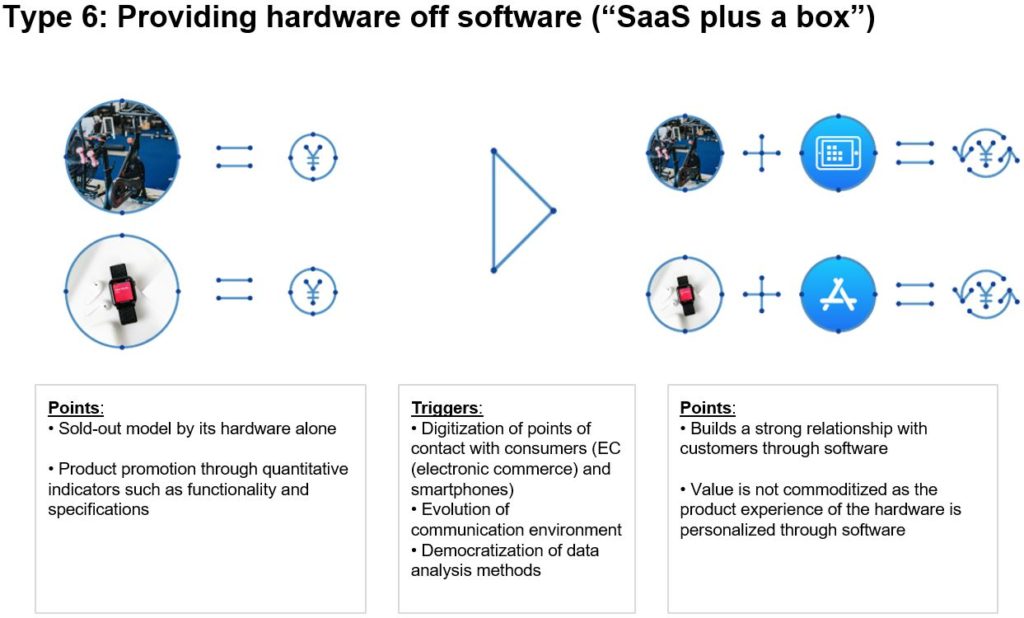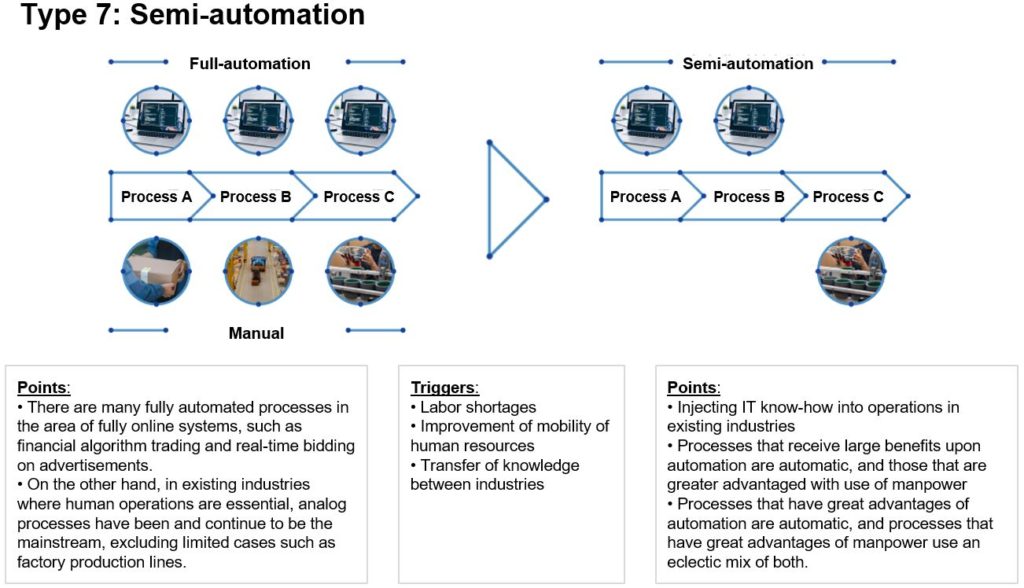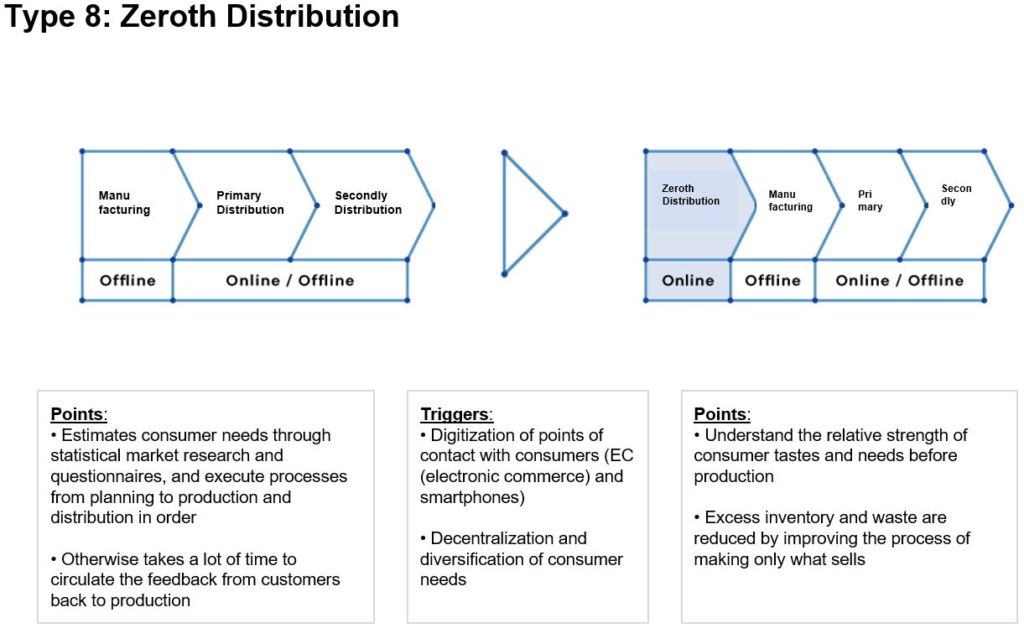The Models of DX #6-9
Types of DX
Here at Genesia Ventures, while focusing on discovering and supporting promising business models that follow the global trends of our everyday world, we’ve been gathering info on digital transformations (DXs). DXs, which come in different types, use technology to improve consumer experiences and maintain sustainable inter-business transactions.
In the DX-Compass released in November last year, we mentioned 5 types of businesses as the basic types of DX businesses, however this time, following on from that, we would like to introduce 4 new types. For those who want to start a business in the DX domain by sharing frameworks from in-house, those who want to build a new business model while in a major company, or those who would like to approach DXs as an investor, we hope that investing in start-ups and supporting growth will see us all moving in the same direction forward towards realising a prosperous society together.

The 6th DX type we’d like to introduce is “Providing hardware off software” (using hardware as a business model to distribute software). Overseas, this is known as “SaaS plus a box”, and the key to this type of DX is to build (rebuild) the relationship with customers starting from software.
In the case of selling hardware alone, the relationship with the customer ends in a single transaction, however in this model the software acts as an anchor with the customer, transforming the point of contact with the customer from flow type to stock type and avoiding the trend of commoditization, as is so common with hardware-only sales, so that the relationship with the customer can be sustained.
The shift from selling products as concepts to selling them as things is not exactly a new idea, but the essence is not that the hardware be 100% replaced by software, but rather that the digitization of contact points with the customer triggers the change of consumer purchasing targets from functions to experiences.
Apple, who has rebuilt the utility value of mobile phones, audio players, and digital watches through iOS and the App Store, is a classic example of this type of DX. There is also an increasing number of emerging players, such as Peloton, who offers and sells exercise bikes through online lessons/community SaaS, and NIO, who enhances consumer experiences with their cars through a mobile app and other services, which are growing significantly thanks to their focus on customer experience as the core value of their business plan. Within our current network of supported companies, Plantio, who is developing an urban micro-farming business by combining mobile apps/online communities with growing management equipment, is also being well-received by users their experience value.

The 7th type is “semi-automation”. Digital and analog systems, which can also be referred to as fully automated and fully manual systems, have traditionally been starkly segregated. However, there are an increasing number of cases where the two processes of automation through software and/or machinery (e.g., financial algorithm trading and real-time advertisement bidding) and human-operated processes (e.g. on-site industries such as customer service and delivery of goods) compete with each other, forming an eclectic fusion of the good points from both types of processes.
Many companies have been promoting mechanization and automation against the backdrop of the national/long-term issue of labor shortages in Japan, and the hurdles for improving operational efficiency have been lowered in recent years due to the introduction and spread of SaaS. The transfer / sharing of know-how between industries has begun as cross-border human resource mobilization has progressed from the web industry to existing industries, or conversely from existing industries to the web industry, mainly among young people in their 20s and 30s. With this as the main background, it seems that the foundation for smooth operation through optimal integration of both digital and analog, with understanding of the advantages and disadvantages of both, is being prepared across industries.
This type of DX is especially important for new businesses, including start-ups in the cross-tech (existing industry x IT) domain. This is because the fully automated approach is not an option in solving industry issues involving complex operations, and even if the procurement for the physical supply capacity can be achieved, scalable business growth will not be possible unless such operations that require a specialist appointed worker are eliminated.
Therefore, when thinking about the necessary steps to achieve semi-automation, first we need to disassemble the entire process to the smallest possible units, then improve the efficiency of each starting from the processes that are easy to automate, eventually achieving full optimization by putting it all together.
Within our network of supported companies, Logisly, who is providing a matching platform for shipping agents and drivers, has refined their model to greatly expand their business. BizteX, who provides services related to workflow optimization for desk workers in Japan, has also newly solved the problem of workflow optimization that cannot be realized by RPA (fully automatic) alone. The newly started iPaaS business, who ultimately provides the workflow (which is what customers actually want), has been growing steadily by incorporating the essence of semi-automation into their services.

The eighth type of DX is “Zeroth distribution” (or “Zero-degree distribution”). This coined term refers to the virtual distribution (pre-marketing) done before primary distribution (retail). The key point of this type is the reversal of manufacturing and sales, which does not separate the two by digitizing the decision-making process of planning for release of a product. This makes it easy to carry out efficient business without waste.
Crowdfunding giant Makuake embodies this model, providing significant value through their services to both consumers and manufacturers. In particular, their service Makuake Incubation Studio provides knowledge on pre-order sales to manufacturers who are considering planning new products. The fact that it functions as an open innovation platform for the manufacturing industry deserves a special mention, in the sense that it greatly promotes the DX of manufacturers.
A few D2C companies in particular represent the manufacturer-Makuake collaborative effort and are actually part of those companies that we are supporting. FOODCODE, who operates TOKYO MIX CURRY, and KANKAK, who operates TAILORED CAFE, quickly and flexibly implements PDCA for planning, production, and sales centered on digitized customer contact points. Additionally, in industries other than manufacturing, in the world of social gaming, pre-registration sites (teaser sites) released prior to the release of the game in order to measure the “pull” of the new title in the social game industry can be said to be a kind of zeroth distribution.

The ninth type is SaaS services providing “know-how”. Compared to regular SaaS, which aims only for cost reduction, it has an advantage in that users can enjoy added value in the form of knowledge in addition to value for money.
The main features of this type of DX is that the specialised knowledge and “know-how” that was previously concentrated under specialists, each in their own specific field, can now be widely distributed to general users. This shows the merit of democratization, which was originally talked about as a feature of software and should be strongly reflected in SaaS as well. Upcoming companies delving into this type of DX are finding success around the board.
There are numerous examples of this type of DX, including Google Cloud Platform, a system/framework manufactured in-house for the development and analysis of Google’s own products by a group of world-class engineers, which has been commercialized for the general public. There’s also Novacell, who has focused on improving the inefficiency and problems they experienced themselves in the process of producing TV commercials into an external sales service called “Optimized TV Commercials”, and favy, who in the process of running a membership-style restaurant have gathered and provide knowledge regarding attracting customers and CRM methods as a vertical SaaS for restaurants.
In terms of our supported companies, entrepreneurs from Shin-Etsu Chemical Co. produced “skill notes”, which are condensed notes of the knowledge from skill education management in the manufacturing industry. These notes, incorporating this type of DX, are helping steadily increase their business performance.
SaaS services providing know-how are effective in solving the problem of difficulty in hiring human resources from the perspective of consumer-oriented companies. For example, hiring a talented marketer from P&G to strengthen marketing is difficult in terms of cost and availability, while accessing a SaaS providing industry know-how from created by entrepreneurs at P&G just costs a few hundred thousand yen per month to use.
In a different case, from the perspective of a vendor company, the knowledge originally contained in the product is further enhanced by the information and knowledge provided by the user. Therefore, there is a network effect and the unit price increases while cancellation rates decrease, adding to overall benefits for an easy-to-accept model.
Of course, we can’t forget to include cost effectiveness as one of the major benefits to introducing SaaS. For any SaaS, when comparing to other software that invoke costs such as those for on-premises software or labor costs, or TCO (Total Cost of Ownership) which encapsulates both, the cost effectiveness will naturally be much higher. Rather than a simple question of whether to use a basic SaaS model or SaaS with know-how provision, it is perhaps more accurate to look at how to combine the elements of the right (value of knowledge and benefits from network effects) and the left (cost effectiveness).
In any case, products that are defined only by their cost effectiveness are structurally easy for customers to differentiate between, so the consideration of this aspect is important from the viewpoint of all B2B businesses, not only SaaS.
Final comments
In this article, we have introduced some of the DX types that we usually use when thinking about business models and emphasised a few in particular. The background of the subject, as mentioned at the beginning, involved discussion on the opinion that in order to realise the true potential of DXs, each company should not pursue efficiency and individual optimization individually, but instead start-ups, large companies, VCs, government agencies, and society as a whole should move together to achieve overall success.
Through DX, the benefits of software such as data transaction transparency and cost reductions are felt widely in in-house operations, inter-business transactions, and consumer experiences. These benefits result in the resolution of uneven distribution of opportunities and asymmetry of availability of information, and honest, solid relationships being built between contractors and commissioners, providers and users, and companies and employees. We hope that together, we can use these services can continue to improve working quality for everyone in our society.


